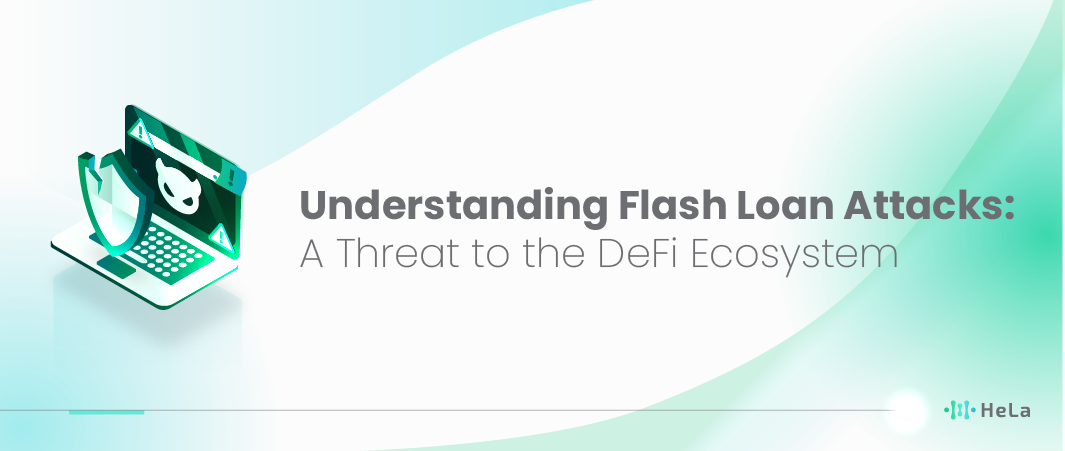A Flash Loan Attack is an attack on the decentralized finance (DeF) ecosystem, built specifically to exploit the features of flash loans. Flash loans offer a new way to borrow assets without any collateral, but the debt must be repaid using the same block as the loan. This is done through smart contracts on blockchain platforms, especially the Ethereum platform. Although flash loans exist for the purpose of efficient arbitrage, collateral swapping, and other trading strategies, it also creates vectors for adversarial control of DeFi protocols.
Thus, in a flash loan attack, the attacker often performs multiple transactions within one block to take advantage of issues in smart contracts or protocols. For example, the attacker may pump and dump tokens on a DEX, exploit a protocol’s governance, or defraud a liquidity pool. Since the whole attack is within one block, the attacker does not need to provide any collateral, which makes these attacks fast and potentially damaging. Hence, the objective of a flash loan attack is to guess when a vulnerable smart contract or the logic behind a certain protocol can be exploited.
The effects of flash loan attacks are evident and have caused very huge losses in DeFi platforms. These events have brought out the need for proper auditing, code review, and good measures that should be enforced in smart contracts. Subsequently, DeFi projects have transitioned to strengthen their security by using approaches such as formal verification, protective measures against such attacks, and encouraging proper smart contract development. However, due to the constant development of DeFi and the attack’s increasing complexity, flash loan attacks are still a significant threat to the sphere.
What Are Flash Loans?

Flash loans are a relatively new type of financial product mostly used in DeFi space, especially when it comes to Ethereum blockchain. Flash loans also do not require borrowers to pledge collateral to obtain massive amounts of cryptocurrency, which is different from conventional loans. This could be made possible by the fact that borrowing, using and paying back of the loan are all done under one transaction block in the blockchain. Flash loans are a new and promising instrument in the sphere of financing, which is based on the blockchain technology and its high speed.
Flash loans are best utilized for applications such as arbitrage, refinancing, and other high-speed financial transactions. Arbitrage involves buying an asset in one market and then simultaneously, selling the same asset in another market to make a profit.
For example, a trader could raise a huge amount of cryptocurrency, purchase an asset at a low price in one region, and then sell it at a higher price in another region, all in one transaction. Also, flash loans can be utilized in overcoming a debt situation, whereby a borrower can change to better rates without an initial capital. This kind of fast and easy access to large sums of money allows for advanced financial management methods which were hard to achieve before.
Another significant characteristic of flash loans is their atomicity, meaning that the underlying loan has to be paid back at the same time with the transaction. If the borrower is unable to finish the repayment of the loan within one transaction block, the entire transaction is rolled back as if it did not take place at all.
This ensures that the lenders do not lose their funds under any circumstance because smart contracts underlying the blockchain technology always execute the repayment condition. This mechanism safeguards the lenders and also preserves the authenticity and security of the loan process, making flash loans to be one of the most secure lending systems in DeFi.
Also Read: 7 Best ASIC Miners for Crypto Mining in 2024
However, flash loans have proven to be a double-edged sword, being hackable yet offering many opportunities and security measures. Adversaries have sometimes targeted flash loans for pump and dump schemes or for exploiting weaknesses within the DeFi ecosystem, resulting in millions of dollars in losses. Such incidents call for increased security requirements and comprehensive auditing of smart contracts in the DeFi space.
However, flash loans remain a powerful weapon to date, the potential of which inspires new ideas and provides unparalleled freedom in financing. They represent the essence of how blockchain technology affects the development of the new financial paradigms that redefine existing financial systems.
How Do Flash Loan Attacks Work?

Flash loan attacks target weaknesses in DeFi protocols and use flash loan’s features to take advantage of them. Flash loans are one of the examples of uncollateralized lending; the borrowing takes place without providing collateral as long as the borrowed funds are returned within the same block of transactions. This mechanism is founded on the fact that all operations in blockchain are atomic, where either all transactions are completed or none at all. This will make sure that the cash is secure in case the borrower fails to repay the loan as agreed. But at the same time, this feature makes it possible to perform complex manipulations by hackers and other malicious actors.
The usual flash-loan attack involves an attacker who acquires a significant amount of cryptocurrency using a flash loan and engages in manipulating the market or exploiting a loophole in a smart contract. For instance, the attacker might leverage the borrowed funds to manipulate the price of an asset on DEX either up or down. Such an attack can open up an arbitrage opportunity, the attacker buys an asset at a lower price in one venue and sells for a higher price in another venue.
Another frequently used attack vector is based on using the weaknesses in the logic of smart contracts. This is because attackers can completely exploit any vulnerability in the contract’s code to embezzle funds. For instance, they may look for ways to circumvent security measures or a method to take advantage of underflow or overflow conditions in mathematics. This is because, through the implementation of a series of transactions in a single block attack, the attacker can alter the contract’s state in ways that would not be possible in a normal flash loan attack. After the malicious operations are done, the attacker returns the flash loan and serves the remaining tokens to the profit he gained from the exploit.
The effects of flash loan attacks are severe, which has been evidenced by massive losses within DeFi platforms and the users of those platforms. These attacks underscore the need for cybersecurity best practices in the creation of smart contracts, as well as the need for code reviews, independent auditors, and other measures to prevent changes in the price of digital assets. With DeFi space expanding, improving the security of such platforms to make them more reliable remains a big task.
Notable Flash Loan Attacks

Flash loan attacks have now emerged as a significant threat in the DeFi sector. This approach is called flash loans, which originated in the Aave protocol that allows users to borrow a significant amount of cryptocurrency without pledging collateral for the loan to be repaid within a single block. Although this approach helps to perform intricate financial operations, it has provided the way to sophisticated threats. In these attacks, hackers target smart contracts and protocols, mainly creating abnormal price movements that cause severe losses.
The first and one of the most well-known cases of flash loan attacks took place in February 2020, and it was directed at the bZx protocol. The attacker took a massive loan and exploited the price of wrapped Bitcoin (WBTC) in Uniswap, a decentralized exchange. Taking advantage of the differential fee rates and placing high leverage on bZx, the attacker was able to drain almost $1 million. This attack not only brought to light the dangers of flash loans, but also demonstrated the deficit of security measures in DeFi protocols.
Harvest Finance protocol was also subject to a significant flash loan attack in November 2020. According to the report, the attacker leveraged flash loans to manipulate the prices of the stablecoins on the dEXs, thus artificially inflating the value of the assets on the Harvest Finance protocol.
This manipulation let the attacker siphon off an unreasonably large sum of money and caused the protocol to suffer a $24 million blow. It sparked discussions about the over-reliance on price oracles and the process through which various DeFi protocols evaluate the value of many assets.
Another recent instance is the flash loan attack that happened to the Alpha Homora protocol in February 2021. Using a flash loan attack, the attacker gained access to the integration between Alpha Homora and Cream Finance and borrowed $37 million. The attacker then employed several combined transactions with leveraged positions and swaps to siphon funds from the protocol.
This attack showed not only the possibility of large financial losses but also the mutual connections between DeFi protocols, where problems in one can be taken advantage of when interacting with another. Such cases demonstrate the importance of the security assessment and cooperation of different platforms to minimize the threats connected with flashloan attacks.
Mitigation Strategies of Flash Loan Attacks
Flash loan attacks take advantage of the flash loan feature, which is instantaneous and permissionless, which means that an attacker can borrow a significant amount of cryptocurrency without collateral, perform the desired transactions, and repay the flash loan in one transaction. To avoid such attacks, the following measures have been employed.
The first way is enhancing the features of smart contract’s construction and deployment. A reentrancy vulnerability, for instance, can be administered by the developers by including reentrancy guards and checks to avoid exploitation. Through contract auditing and testing it is possible to detect any vulnerability that may exist in the smart contracts before a hacker gets to discover it.
Another offset measure is the proper usage of high-quality price oracle strategies. Another popular method of using flash loans is to leverage the price of one or more assets on a DEX. Thus, it becomes rather challenging for the attackers to change prices within the same transaction when using decentralized oracles that gather data from various sources. Also, such methods as time-weighted average prices (TWAP) or other variations can be applied to reduce the impact of short-term price changes and therefore, it will be much harder for the attackers to exploit those changes effectively.
Also Read: Top 10 Crypto Asset Management Companies in 2024
Finally, it is crucial to note that the implementation of risk management frameworks and monitoring tools will greatly enhance the ability to prevent and mitigate flash loan attacks. The liquidity of the loaning platforms can restrict the size of flash loans depending on the platforms’ liquidity and monitor the activities in real-time as a way of preventing bad practices.
In addition, raising awareness and implementing security guidelines and continuous security best practice among developers and users could contribute to a safer decentralized finance (DeFi). The nature of flash loans makes them challenging to defend against, requiring frequent updates and upgrades of protocols to protect against such threats.
Conclusion
A Flash Loan Attack takes its cue from flash loans in decentralized funding models where it is possible to borrow large amounts of Cryptocurrency without requiring collateral as long as the credit facility is repaid at once in a single block. To maximize the exploitable line of credit and reduce costs, attackers rely on this instantaneous borrowing power to alter spot prices of cryptocurrencies in different exchange platforms, commercially exploit susceptibilities in smart contracts, or perform a sequence of high-speed trades so as to steal considerable profits before the transaction is complete. These attacks target decentralized applications based on complicated and frequently integrated smart contracts and harm defectors that are comprehensively and efficiently exploited by such crimes.
In conclusion, this post outlined how the Flash Loan Attacks clearly demonstrate the two-sides perspective of the innovation within the DeFi. Even though flash loans may indeed represent sound trading possibilities for arbitrage and market making, the abuse of this particular financial tool points to severe security deficiencies that will result in substantial losses. Such occurrences increase the need for better security, exhaustive reviewing, and strong contract structures in order to improve the protection of DeFi.
Disclaimer: The information provided by HeLa Labs in this article is intended for general informational purposes and does not reflect the company’s opinion. It is not intended as investment advice or a recommendation. Readers are strongly advised to conduct their own thorough research and consult with a qualified financial advisor before making any financial decisions.

